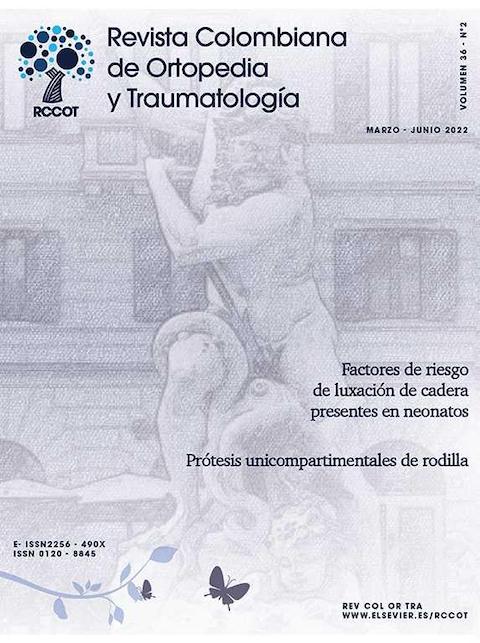Factores de riesgo de luxación de cadera presentes en neonatos de un hospital infantil
DOI:
https://doi.org/10.1016/j.rccot.2022.04.012Palabras clave:
luxación congénita de cadera, factores de riesgo, cadera, articulación de la cadera, osteoartritis de la caderaResumen
Introducción: La Displasia de la Cadera en Desarrollo (DCD) tiene repercusiones importantes en la salud si no es diagnosticada y tratada oportunamente. El objetivo de esta investigación es describir los factores de riesgo y prevalencia para DCD en nacidos entre el 01/01/2016 al 31/12/2019 en un Hospital Infantil de Bogotá, Colombia.
Materiales y métodos: Estudio descriptivo de corte transversal. Se evaluó clínicamente la Luxación de la Cadera en Desarrollo (LCD) a través de los signos de Ortolani, Barlow y Galeazzi explorando la posible asociación con los antecedentes familiares en primer y segundo grado de consanguinidad. Se crearon tablas de contingencia 2x2 y aplicación de la prueba X2 o la prueba exacta de Fisher, considerándose una significancia estadística de (p< 0.05). La información se tomó de la base de datos del programa de tamización para LCD. El análisis descriptivo se realizó con Stata15 y SPSS20.
Resultados: 3193 neonatos cumplen con criterios de inclusión. El 49.5% son femeninos. El 7.1% tiene antecedente familiar de DCD en primer grado de consanguinidad, el 5% en segundo grado de consanguinidad y el 9.1% tuvieron presentación podálica. La evaluación clínica para la detección de DCD fue positiva en 0.41% (n = 13). Se documentó una prevalencia de 2.2 x cada 1000 nacidos vivos.
Conclusiones: No se documentó la asociación entre el sexo y el antecedente de primer grado de consanguinidad, pero sí una asociación con los antecedentes en segundo grado. La prevalencia estimada en un solo hospital pone en evidencia la importancia de fortalecer y expandir los programas de tamización.
Nivel de evidencia: III. Estudio descriptivo de corte transversal.
Descargas
Referencias bibliográficas
Patel H. Preventive health care, 2001 update: screening and management of developmental dysplasia of the hip in newborns. CMAJ. 2001;164:1669-77.
Vaquero-Picado A, Gonzalez-Moran G, Garay EG, Moraleda L. Developmental dysplasia of the hip: update 1. Patel H. Preventive health care, 2001 update: screening and management of developmental dysplasia of the hip in newborns. CMAJ. 2001;164:1669-77. 2. Vaquero-Picado A, Gonzalez-Moran G, Garay EG, Moraleda L. Developmental dysplasia of the hip: update of management. EFORT open reviews. 2019;4:548-56, http://dx.doi.org/10.1302/2058-5241.4.180019.
Viere RG, Birch JG, Herring JA, Roach JW, Johnston CE. Use of the Pavlik harness in congenital dislocation of the hip. An analysis of failures of treatment. J Bone Joint Surg Am. 1990;72:238-44.
Bache CE, Clegg J, Herron M. Risk factors for developmental dysplasia of the hip: ultrasonographic findings in the neonatal period. J Pediatr Orthop B. 2002;11:212-8, http://dx.doi.org/10.1097/00009957-200207000-00004.
Chan A, McCaul KA, Cundy PJ, Haan EA, Byron-Scott R. Perinatal risk factors for developmental dysplasia of the hip. Arch Dis Child Fetal Neonatal Ed. 1997;76:F94-100, http://dx.doi.org/10.1136/fn.76.2.f94.
Albinana J, Quesada JA, Certucha JA. Children at high risk for congenital dislocation of the hip: late presentation. J Pediatr Orthop. 1993;13:268-9.
Tonnis D, Storch K, Ulbrich H. Results of newborn screening for CDH with and without sonography and correlation of risk factors. J Pediatr Orthop. 1990;10:145-52.
Walter RS, Donaldson JS, Davis CL, Shkolnik A, Binns HJ, Carroll NC, et al. Ultrasound screening of high-risk infants. A method to increase early detection of congenital dysplasia of the hip. Am J Dis Child. 1992;146:230-4, http://dx.doi.org/10.1001/archpedi.1992.02160140096028.
Lehmann HP, Hinton R, Morello P, Santoli J. Developmental dysplasia of the hip practice guideline: technical report. Committee on Quality Improvement, and Subcommittee on Developmental Dysplasia of the Hip. Pediatrics. 2000;105:E57, http://dx.doi.org/10.1542/peds.105.4.e57.
Shipman SA, Helfand M, Moyer VA, Yawn BP. Screening for developmental dysplasia of the hip: a systematic literature review for the US Preventive Services Task Force. Pediatrics. 2006;117:e557-76, http://dx.doi.org/10.1542/peds.2005-1597.
Clinical practice guideline: early detection of developmental dysplasia of the hip. Committee on Quality Improvement, Subcommittee on Developmental Dysplasia of the Hip. American Academy of Pediatrics. Pediatrics. 2000; 105(4 Pt 1):896-905. doi: 10.1542/peds.105.4.896.
Turriago C, Medina A, Uribe IC, Vargas VA, Ardila M. Oportunidad diagnóstica de la displasia de la cadera en desarrollo: Diferencia entre el sistema de seguridad social en salud contributivo y los sistemas de medicina prepagada y particular en Bogotá. Rev Col Or Tra. 2012;26:153-7.
Hvid I. Neonatal hip instability, developmental dysplasia of the acetabulum, and the risk of early osteoarthrosis. Acta Orthop. 2008;79:311-2, http://dx.doi.org/10.1080/17453670710015184.
American Academy of Orthopedic Surgeons. Detection and Nonoperative Management of Pediatric developmental dysplasia of the hip in infants up to six months of age. United State: AAOS; 2014.
de Hundt M, Vlemmix F, Bais JMJ, Hutton EK, de Groot CJ, Mol BWJ, et al. Risk factors for developmental dysplasia of the hip: a meta-analysis. European Journal of Obstetrics and Gynecology and Reproductive Biology. 2012;165:8-17, http://dx.doi.org/10.1016/j.ejogrb.2012.06.030.
Tan SHS, Wong KL, Hui JH. Incorporating risk factors in the development of the screening programme for developmental dysplasia of the hips. J Pediatr Orthop B. 2019;28:111-4, http://dx.doi.org/10.1097/BPB.0000000000000567.
Hegde D, Powers N, Nathan EA, Rakshasbhuvankar AA. Developmental dysplasia of the hip in preterm breech infants. Archives of Disease in Childhood - Fetal and Neonatal Edition. 2020, fetalneonatal-2019-317658.
Ortiz-Neira CL, Paolucci EO, Donnon T. A meta-analysis of common risk factors associated with the diagnosis of developmental dysplasia of the hip in newborns. Eur J Radiol. 2012;81:e344-51, http://dx.doi.org/10.1016/j.ejrad.2011.11.003.
Mulpuri K, Schaeffer EK, Andrade J, Sankar WN, Williams N, Matheney TH, et al. What Risk Factors and Characteristics Are Associated With Late-presenting Dislocations of the Hip in Infants? Clin Orthop Relat Res. 2016;474:1131-7, http://dx.doi.org/10.1007/s11999-015-4668-0.
Stevenson DA, Mineau G, Kerber RA, Viskochil DH, Schaefer C, Roach JW. Familial predisposition to developmental dysplasia of the hip. J Pediatr Orthop. 2009;29:463-6, http://dx.doi.org/10.1097/BPO.0b013e3181aa586b.
Feldman GJ, Parvizi J, Sawan H, Erickson JA, Peters CL. Linkage mapping and whole exome sequencing identify a shared variant in CX3CR1 in a large multigeneration family. J Arthroplasty. 2014;29 9 Suppl:238-41, http://dx.doi.org/10.1016/j.arth.2014.05.014.
Feldman G, Offemaria A, Sawan H, Parvizi J, Freeman TA. A murine model for developmental dysplasia of the hip: ablation of CX3CR1 affects acetabular morphology and gait. J Transl Med. 2017;15:233, http://dx.doi.org/10.1186/s12967-017-1335-0.
Kenanidis E, Gkekas NK, Karasmani A, Anagnostis P, Christofilopoulos P, Tsiridis E. Genetic Predisposition to Developmental Dysplasia of the Hip. The Journal of arthroplasty. 2020;35:291-300, http://dx.doi.org/10.1016/j.arth.2019.08.031, e1.
Wynne-Davies R. Acetabular dysplasia and familial joint laxity: two etiological factors in congenital dislocation of the hip. A review of 589 patients and their families. J Bone Joint Surg Br. 1970;52:704-16.
Lowry CA, Donoghue VB, O’Herlihy C, Murphy JF. Elective Caesarean section is associated with a reduction in developmental dysplasia of the hip in term breech infants. J Bone Joint Surg Br. 2005;87:984-5, http://dx.doi.org/10.1302/0301-620X.87B7.16073.
Moore FH. Examining infants’ hips–can it do harm? The Journal of bone and joint surgery British volume. 1989;71:4-5.
Panagiotopoulou N, Bitar K, Hart WJ. The association between mode of delivery and developmental dysplasia of the hip in breech infants: a systematic review of 9 cohort studies. Acta Orthop Belg. 2012;78:697-702.
Symonds EM, Symonds IM. Essential obstetrics and gynaecology. 4 ed. New York: Churchill Livingstone; 2008.
Lennox IA, McLauchlan J, Murali R. Failures of screening and management of congenital dislocation of the hip. J Bone Joint Surg Br. 1993;75:72-5.
Shorter D, Hong T, Osborn DA, Cochrane Review:. Screening programmes for developmental dysplasia of the hip in newborn infants. Evid Based Child Health. 2013;8:11-54, http://dx.doi.org/10.1002/ebch.1891.
Sink EL, Ricciardi BF, Torre KD, Price CT. Selective ultrasound screening is inadequate to identify patients who present with symptomatic adult acetabular dysplasia. J Child Orthop. 2014;8:451-5, http://dx.doi.org/10.1007/s11832-014-0620-1.









